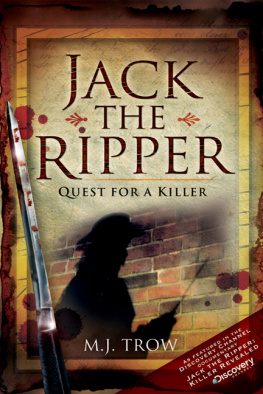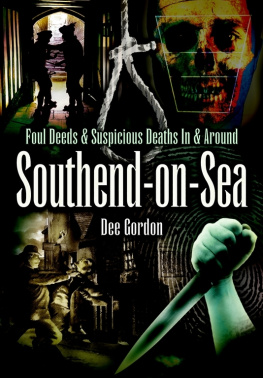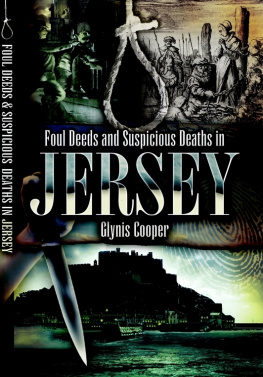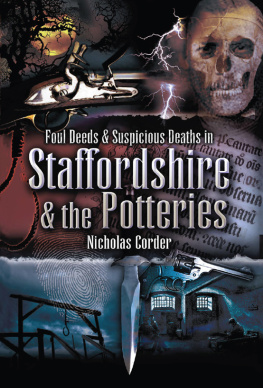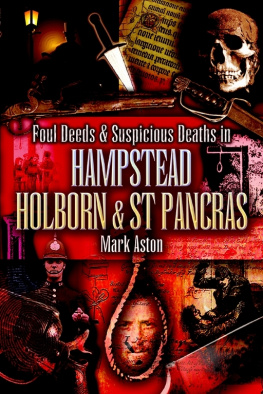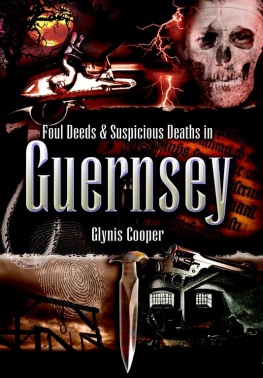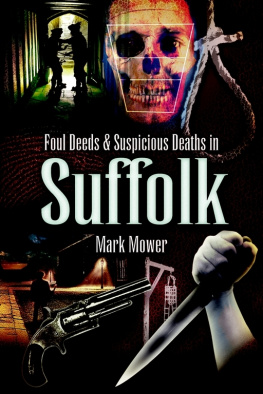
TRUE CRIME FROM WHARNCLIFFE
Foul Deeds and Suspicious Deaths Series
Barking, Dagenham & Chadwell Heath
Barnet, Finchley and Hendon
Barnsley
Bath
Bedford
Birmingham
Black Country
Blackburn and Hyndburn
Bolton
Bradford
Brighton
Bristol
Cambridge
Carlisle
Chesterfield
Colchester
Cotswolds, The
Coventry
Croydon
Derby
Dublin
Durham
Ealing
Fens, In and Around
Folkstone and Dover
Grimsby
Guernsey
Guildford
Halifax
Hampstead, Holborn and St Pancras
Huddersfield
Hull
Jersey
Leeds
Leicester
Lewisham and Deptford
Liverpool
London's East End
London's West End
Manchester
Mansfield
More Foul Deeds Birmingham
More Foul Deeds Chesterfield
More Foul Deeds Wakefield
Newcastle
Newport
Norfolk
Northampton
Nottingham
Oxfordshire
Pontefract and Castleford
Portsmouth
Rotherham
Scunthorpe
Shrewsbury and Around Shropshire
Southampton
Southend-on-Sea
Staffordshire and The Potteries
Stratford and South Warwickshire
Tees
Uxbridge
Warwickshire
Wigan
York
OTHER TRUE CRIME BOOKS FROM WHARNCLIFFE
A-Z of London Murders, The
A-Z of Yorkshire Murders, The
Black Barnsley
Brighton Crime and Vice 1800-2000
Crafty Crooks and Conmen
Durham Executions
Essex Murders
Executions & Hangings in Newcastle
and Morpeth
Great Hoaxers, Artful Fakers and
Cheating Charlatans
Norfolk Mayhem and Murder
Norwich Murders
Plot to Kill Lloyd George
Romford Outrage
Strangeways Hanged
Unsolved Murders in Victorian &
Edwardian London
Unsolved London Murders
Unsolved Norfolk Murders
Unsolved Yorkshire Murders
Warwickshire's Murderous Women
Yorkshire Hangmen
Yorkshire's Murderous Women
Please contact us via any of the methods below for more information or a catalogue
WHARNCLIFFE BOOKS
47 Church Street, Barnsley, South Yorkshire, S70 2AS
Tel: 01226 734555 734222 Fax: 01226 734438
email: enquiries@pen-and-sword.co.uk
website: www.wharncliffebooks.co.uk

First Published in Great Britain in 2009 by
Wharncliffe Books
an imprint of
Pen and Sword Books Limited ,
47 Church Street, Barnsley ,
South Yorkshire. S70 2AS
Copyright M.J. Trow, 2009
ISBN: 978 184563 088 1
eISBN: 978 178303 747 6
The right of M J Trow to be identified as author of this work has been asserted by him in accordance with the Copyright, Designs and Patents Act, 1988.
A CIP catalogue record of this book is available from the British Library.
All rights reserved. No part of this book may be reproduced, stored in a retrieval system, or transmitted, in any form or by any means, electronic, mechanical, photocopying, recording or otherwise, without the prior permission in writing of the publishers.
Typeset in Plantin and Benguiat by
S L Menzies-Earl
Printed in the UK by the MPG Books Group
Pen & Sword Books Ltd incorporates the imprints of
Pen & Sword Aviation, Pen & Sword Maritime,
Pen & Sword Military, Wharncliffe Local History, Pen & Sword Select,
Pen & Sword Military Classics, Leo Cooper, Remember When, Seaforth Publishing
and Frontline Publishing
For a complete list of Pen & Sword titles please contact:
PEN & SWORD BOOKS LIMITED
47 Church Street, Barnsley, South Yorkshire, S70 2AS, England.
Email: enquiries@pen-and-sword.co.uk
Website: www.pen-and-sword.co.uk
Contents
Acknowledgements
M y thanks go to the following for their co-operation and spirit of friendliness in the production of this book: the editor and staff of the Isle of Wight County Press , the licensees and staff of the Hare and Hounds public house, Downend, the licensees and staff of the Buddle Inn , Niton, the churchwarden and PCC, Newport Minster, Andrew Ross, Hairdressing, Newport, Just You beauticians, Newport.
I would also like to thank Mrs Debbie Galvin for her help, and above all my good lady wife, Carol Trow, for many hours trekking over the Isle of Wight in all weathers to take the photographs in this book. And finally to my son, Tali, who knows where the bodies are buried!
Chapter 1
Alarums and Incursions
T here is only one line that tells us anything about the Roman invasion of the Isle of Wight. The biographer Suetonius wrote that Vespasian, sweeping along the south coast with the II Legio Augusta, took Vectis (the Island), defeated two warlike tribes ( validissime gentes ) and captured over twenty fortresses ( oppida ). The tribes were probably the Durotriges of what is today Dorset and the Dobunni further east in what would become Hampshire and Sussex. The fortresses are more likely to be hill-top forts on the mainland, but there is at least the possibility of one standing on a hill in the centre of the Island which is now the site of Carisbrooke Castle.
What was Vespasian doing in the Island in the first place? He was part of the Claudian invasion of AD 43, but that is in itself a misnomer. The Emperor Claudius was hardly the stuff of which soldiers are made and if he was not exactly the limping, stammering idiot of Robert Graves famous novel, he was certainly no general. He turned up, as Emperors often did, at the very end of the campaign, to claim laurels and wave to crowds - and came nowhere near Vectis.
The hard work was done by Aulus Plautius, who began a systematic attack on the disunited tribes of Britain, using the formidable tactics of the Roman legions. Worthy opponents like Caratacus were driven back into the forested mountains of Wales and Vespasian, with just a single legion, was taking a huge gamble in his march westward along the south coast.

Location map 1 . The author

The general who conquered the Isle of Wight the future emperor Vespasian, from a marble bust . The author
With his cavalry, his auxiliary units, his legion, siege engines and ballistae, he may have had 10,000 men at his back but that was probably more than the total number of fighting men in the Isle of Wight.
The fact that Suetonius makes so little of the Roman invasion of the Island and that other writers do not refer to it at all, probably implies that there was little or perhaps no resistance. The rapidly growing imperium that was Rome meant that southern regions of Britannia, including the island, had been trading with the eternal city for at least a generation by the time Vespasian arrived. Pre-Claudian coins have been found here and amphorae discovered in marine silt are evidence of a thriving wine import. We know that Celtic leaders in southern Britain like Togodumnos based at Chichester, were only too happy to accept a latinized version of his name and all the panoply of Roman client kingship that went with it.
What has survived from the Roman period of Vectis is a string of villas, eight of which have so far been discovered, implying an ordered, settled, peaceful way of life. Military camps, of the type found at legionary bases from Exeter to the later Hadrians Wall, do not feature and probably never did. Only at Carisbrooke, at the base of the Norman earthworks thrown up in the 1070s, do we have a section of a stone wall which is probably Roman.
Next page

